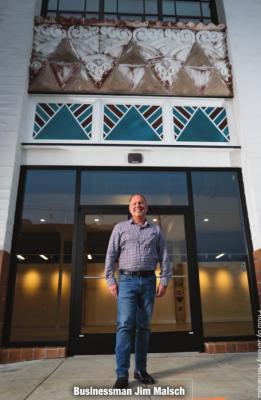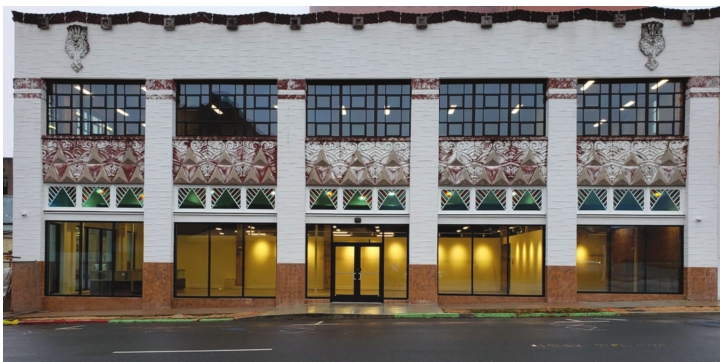A Building’s Rebirth

Jim Malsch puts a personal touch on the new Andress Arts and Entrepreneur Center
Over the past year, people have been transfixed on the change happening at 717 Crockett St. Improvements could be seen weekly during our year of Covid-19, proving that good things can happen even in really rotten years. The 1920s Sam Wiener-designed building both deserved the rehab and was lucky to get it. After years of neglect, it was a mess, not only esthetically but structurally. One set of owners floated the idea of tearing it down to create yet another ugly parking lot.

Businessman Jim Malsch saw the building’s promise and put together a team that has brought the historic structure back to life. Tenants are moving into the topfloor offices, which are now totally leased.
The synergy created by the tenants – an attorney, a graphic designer, a photographer and other professional and personal services – will create all sorts of networking and partnership opportunities for the businesses that are located there. Furniture will soon be delivered for the 3,500 square feet of open space outside the offices that will be set up as individual coworking spaces for those who want to work in a professional setting but don’t need a separate office.
There are smaller work/studio spaces for artists on the ground floor, along with a clean room for artists to wash art brushes and other supplies, and a gallery space for the Andress artists to host exhibits and show and sell their work. Four of these artist workspaces are claimed so far, with that number changing daily. An art-themed retail store that plans to open in the first quarter of 2021 will dominate the first-floor storefront. In a year that has been nothing short of bad, ugly and tragic, the return to life of this beautiful building is something that fits firmly in the category of happy, beautiful and so very good.
The latest owner, Shreveporter Jim Malsch, has become the latest unintentional caretaker of history. After 25 years with Enterprise Computing Services (ECS), a business he co-founded, he was ready for another phase of life. He had spent several years on the board of Cohab, a Shreveport coworking space whose goal is to give entrepreneurs the skills they need to be successful long term and had become a “serial investor” in start-ups with a smart business plan, drive and determination. Along the way, he picked up ownership stakes in Shreveport Music, Whisk, SkyCoach, Red River Brewpub and other businesses with entrepreneurs at the helm that seemed to have the skill and moxie to make it. He invested not only money but smarts, willingly sharing his knowledge of owning and running a successful business.
 Malsh had a concept of what he wanted to do – create a space for entrepreneurs and artists based loosely on the Cohab model – but he needed a place to do it. Enter the remarkable building at 717 Crockett, a once colorful and ornate Art Deco car dealership designed by Shreveport architect Sam Wiener Jr. By the time Malsch started looking at the building, its heyday was long past. Traces of its beautiful terra-cotta ornamentation were still there, but it was a lifeless place with roof leaks, broken windows and crumbling plaster. To Malsch and others, the building and its history were a part of Shreveport’s story that needed to be saved.
Malsh had a concept of what he wanted to do – create a space for entrepreneurs and artists based loosely on the Cohab model – but he needed a place to do it. Enter the remarkable building at 717 Crockett, a once colorful and ornate Art Deco car dealership designed by Shreveport architect Sam Wiener Jr. By the time Malsch started looking at the building, its heyday was long past. Traces of its beautiful terra-cotta ornamentation were still there, but it was a lifeless place with roof leaks, broken windows and crumbling plaster. To Malsch and others, the building and its history were a part of Shreveport’s story that needed to be saved.
Dec. 16, 1929, was a big day. It was the day Benton Howard announced the formal opening of his new Ford and Lincoln dealership at 717 Crockett St. The festive grand opening gala was planned the following night from 8 until 11 p.m. and would show off a building “specifically designed to suit the character of the business.” The original building featured showroom walls with “natural tone textone (paint)” and green and gray tiles on the floor to complement the vehicles sitting on it. Natural light from huge windows would flood the showroom floor, so no artificial lighting was needed during the day.
At the rear of the ground-floor car display area were the corporate offices for Howard Motor Co. president Benton Howard and P. “Murph” O’Neal, vice-president and general manager. Next to their offices was the used car display space, and up the ramp was the service floor where one could find “every conceivable appliance and apparatus necessary for the proper servicing of Ford and Lincoln cars.” It was apparent no expense had been spared. The building, estimated at the start of construction to cost $55,000, came in at $100,000, a sizeable increase. Consider that the buying power of $100,000 in 1929 is $1.5 million today.
Timing, as they say, is everything. The grand dealership, called the “most outstanding automobile building in Shreveport,” opened two months after the stock market crash of October 1929, heralding the start of the Great Depression. Millions of investors were wiped out; banks and businesses closed; homes, farms and jobs were lost; and likely the last thing most needed was a fine new Ford or Lincoln car. In August of 1930, Sam Wiener, the building’s architect, sued alleging nonpayment of a $40,000 note, forcing Howard into receivership. By 1931, two years into the Great Depression, Howard was forced to liquidate everything, and the next owner, Redden Thaddeus “Thad” Andress, a graduate of West Point who would become a veteran of both world wars, became the person for whom the building was forever known.
Malsch and his general contractor, CC&D, have been hard at work on the building, now called the Andress Artist & Entrepreneur Center, since February 2020. Though construction continued through the worst of COVID, the pandemic slowed everything – from government responsiveness to historic rehab questions to the manufacture of new windows. “I didn’t think it was going to be easy,” says Malsch of his first historic building rehabilitation. “There were just a lot of moving parts. I learned to be patient and to respect the knowledge of the contractor and his subs.” Malsch is glowing in his praise for CC&D and owner Fred White, a man he calls a “class act.”
There
were no real surprises, but every time Malsch looks at the building, he
is awed by its structure and the original craftsmanship. Much of the
original look has been returned to the building; the signature stained
glass inserts and large windows have made a
stunning difference in the facade. The Mayan-inspired molding has been
cleaned and repaired, the roof replaced, concrete work finished,
electrical, HVAC and plumbing systems installed. Malsch says knowing
what he knows now, he would do it all over again.
The city’s Certificate of Occupancy is in hand, and soon, Malsch and other tenants on the second floor will move in and get settled. In a couple of months, the retail Downtown Art House (DAH) store should be open, signaling the completion of the Andress Artist and Entrepreneur Center. Malsch and DAH owner Cassie Stone plan to host regular art and food truck events. A small parking lot adjacent to the building will be the perfect venue for an intimate food truck court, and given Jim’s background, it is a sure bet that live music will be a regular occurrence.
Malsch is hoping his commitment to the project will help others nearby and be a catalyst for additional activity.
Chances are good that will happen. Work
is scheduled to resume in 2021 on Every Man a King Distillery at the old
Arlington Hotel, apartments are now being rented at The Southern Belle a
half-block away (see our story on page 6), and additional amenities are
planned for 2021 for Caddo Common park. Malsch is happy to welcome more
people downtown. He will have a cool office to go to every day and will
be around creative and artistic people in a beautiful historic building
he saved for future generations. It’s hard to imagine what could be
better.

